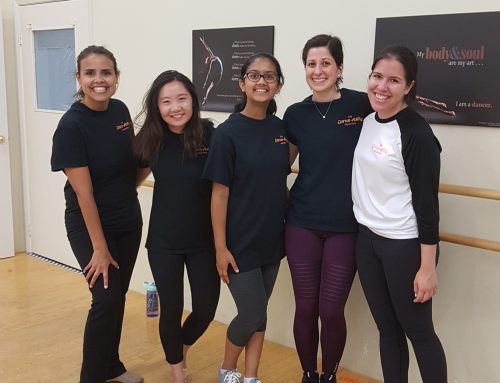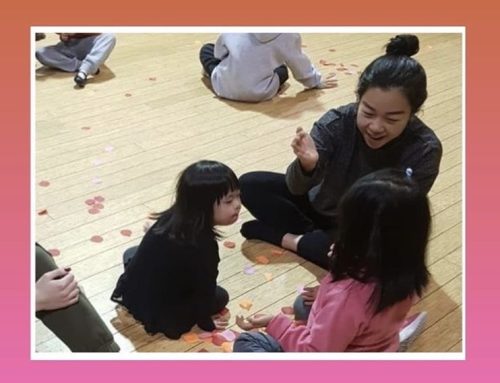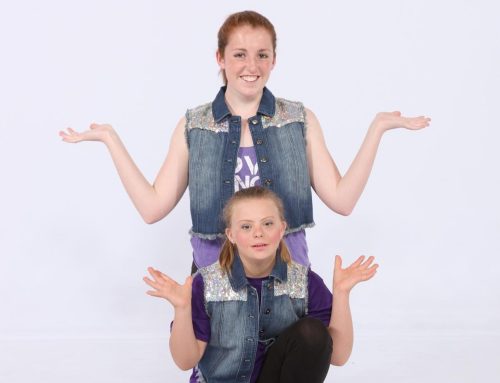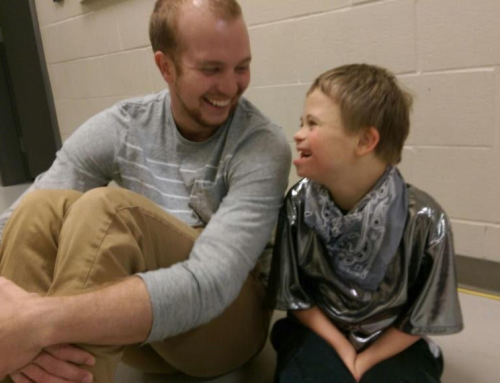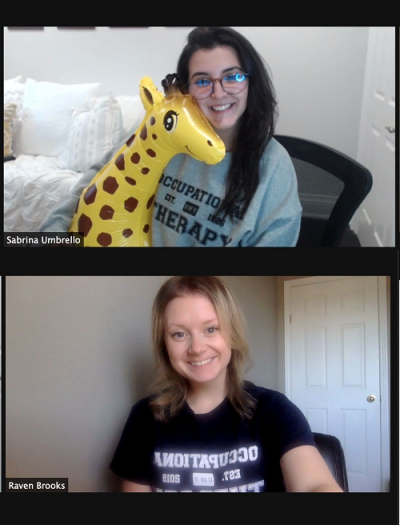 Dance parties, virtual backgrounds, endless laughs, “Hey Baby!”, die-hard Disney fans and an inflatable giraffe – just a few of the many things that defined our placement experience at the Dance Ability Movement (DAM). As two student Occupational Therapists (OTs) with a dance background, if you would’ve asked us 10 weeks ago what it meant to be a dancer, our definition would’ve been drastically different compared to what it is now. From defining dance as pointed toes, straight arms, perfect ballet buns and looking uniform on stage, we have broken down these barriers and have changed the way we see dance forever. What does the word “dance” mean to us now after concluding our 10-week OT placement with the Dance Ability Movement? A few keywords come to mind: inclusion, connection, belonging, creative expression, participation, engagement and most importantly, FUN.
Dance parties, virtual backgrounds, endless laughs, “Hey Baby!”, die-hard Disney fans and an inflatable giraffe – just a few of the many things that defined our placement experience at the Dance Ability Movement (DAM). As two student Occupational Therapists (OTs) with a dance background, if you would’ve asked us 10 weeks ago what it meant to be a dancer, our definition would’ve been drastically different compared to what it is now. From defining dance as pointed toes, straight arms, perfect ballet buns and looking uniform on stage, we have broken down these barriers and have changed the way we see dance forever. What does the word “dance” mean to us now after concluding our 10-week OT placement with the Dance Ability Movement? A few keywords come to mind: inclusion, connection, belonging, creative expression, participation, engagement and most importantly, FUN.
The DAM has shifted dance culture one small step at a time and has provided quality services over the last decade. So, in honour of 11 years of the DAM, here are 11 things that this placement experience has taught us.
- You learn the most from the amazing people you are working with. Dancers are the experts in their own lives.
In coming into a new placement, we expected to learn the most from our preceptors, Mallory and Jade. They both taught us so much about how to be a leader and a mentor, and what it truly means to enable occupation for individuals of all abilities. Although we have learned more than we could have imagined from Mal and Jade, what we did not anticipate was how much we would really learn from the dancers in every single class. The dancers taught us so much about what it means to have fun, express yourself creatively and this idea that “functional” looks different for everyone. Their dedication, excitement, enthusiasm and love for dance inspired us to view dance differently, and see how breaking down environmental barriers makes a dance class accessible and inclusive for individuals of all abilities.
- How to support one another.
We were lucky enough to have one another to lean on throughout this placement, as well as having an incredible team at the DAM to support us throughout our 10 weeks. We have learned so much about working on a team, and truly believe that the support of those around you makes all the difference in providing quality services to those we are working with. We worked hard to use our clinical reasoning, knowledge and love for dance to help support our team and dancers in and out of the dance class. One thing we could not have predicted was the support that WE received from the dancers. In one of our weekly Disney socials, we provided positive reinforcement to the dancers saying things like, “amazing job dancers”, “you did a great job tonight” only to hear an influx of incredibly supportive and heartwarming comments like “No, good job to YOU Sabrina and Raven!”. The kindness, enthusiasm, trust and excitement that we were met with every week by the dancers, is something that we could never have imagined, but are so incredibly grateful for.
- How to be adaptable and flexible.
Our time with the DAM showed us that things may not always go the way you plan, but you can always find a way to be creative and use your skills to work through it. Being adaptable is one of the OT enablement skills discussed in the Canadian Model of Client-Centred Enablement (CMCE) (Townsend & Polatajko, 2007). We constantly adapted our plan during the Disney social events based on the dancers’ interests and when we noticed that dancers were really engaged in discussions during the breakout rooms, we thought more time for connection with others was beneficial.
- How to have fun.
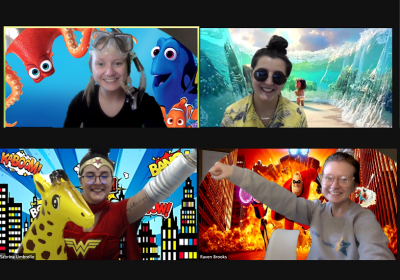 Although we are entering the professional healthcare field of OT, the DAM community taught us that being professional doesn’t mean we can’t have fun! We realized that by modelling having genuine fun, the dancers are more likely to engage in the activities and have fun themselves. Dressing up every week or changing our Zoom backgrounds to match the theme for the Disney social events was just one way we tried to incorporate fun for the dancers.
Although we are entering the professional healthcare field of OT, the DAM community taught us that being professional doesn’t mean we can’t have fun! We realized that by modelling having genuine fun, the dancers are more likely to engage in the activities and have fun themselves. Dressing up every week or changing our Zoom backgrounds to match the theme for the Disney social events was just one way we tried to incorporate fun for the dancers.
- The value of connection for mental health and wellbeing.
Over the last year of the pandemic, the social distancing measures and lack of face-to-face interaction has had a large impact on mental health and wellbeing. Using our OT lens and clinical reasoning, we developed and implemented weekly Disney themed socials for the dancers. Although we had a variety of fun games, dance parties, creative outfits and backgrounds to match our themes, the most important component of these weekly socials was the opportunity for connection. We often underestimate how impactful a simple wave, smile, or “hello” can be. The shared interests of Disney themes facilitated a sense of connection and belonging. In providing opportunities for the dancers to connect and cultivate friendships with their peers across the virtual platform, we as facilitators felt the positive impacts of these social connections on our own physical and mental health during these tough times.
- The DAM enables friendships.
Learning and implementing the F-Words for Child Development (Fun, Friends, Family, Function, Fitness, Future) into dance classes during this placement was a great learning opportunity for us. While we helped to facilitate friendships during the social events and during dance classes, we are really grateful to have experienced how the DAM promotes and helps cultivate friendships first-hand. As two students randomly placed together to take on this placement, the DAM enabled our friendship to form. Right away, we could see the value in helping to facilitate friendships, and it inspired us to help grow an existing initiative, the Pen Friends Program, for the DAM community so that others would have the opportunity to build a great friendship like we did. For more information on the F-Words for Child Development and how they’re used in practice, click here.
- How we can be leaders as OTs.
Mallory and Jade demonstrated to us on so many occasions how we can be leaders in OT. Not only have they started a business incorporating a very unique OT role, but they have also demonstrated many characteristics of transformational leaders (Duncan, 2021). They encouraged us and others to share their best selves, constantly inspired us and we know they inspire many dancers, volunteers and instructors, and are so motivating (Duncan, 2021). Transformational leaders like Mallory and Jade also value equality/equity, autonomy and creativity, which to us, perfectly depicts the amazing OTs that they are (Duncan, 2021). We are lucky to have had great leadership role models throughout these 10 weeks and aspire to be transformational leaders like them.
- What inclusion really means.
The DAM community has taught us the real meaning of inclusion. Inclusion is not just about inviting people of all abilities to come and join a dance class. Inclusion is about seeing the strengths and uniqueness of every single person in the class and shifting perspectives, the dance culture and attitudes towards what society may deem as “functional”. Over the last 10 weeks, we have developed and refined our skills in recognizing environmental barriers and learned how changing the environment is the solution, rather than trying to change a dancer. This way, every single person in the class can participate, engage meaningfully and flourish as a dancer. The dance community should be a place where everyone feels safe and belongs and creating an inclusive space is a skill that we will be taking with us in our future careers. The DAM has changed the way we see dance and has truly re-defined what it means to be a part of an inclusive dance community.
- How important creating a sense of belonging is.
We learned in school about the Doing-Being-Becoming model (Wilcock, 1998) where belonging is at the centre of these three things. But until we began this placement, we did not really understand what belonging meant. The DAM works diligently to provide an inclusive environment, a sense of community, and an opportunity for everyone in the DAM community to be an equal member, all of which contribute to helping someone feel as though they belong. We knew that one of our roles as Student OTs was to help cultivate this sense of belonging by connecting with the dancers and their families, coaching others on how to provide an inclusive and accessible environment, and welcoming everyone to the social events to just have fun. We hope that we cultivated a sense of belonging for all dancers during the social events. When we reflected on this opportunity to lead the social events, we were so surprised at how comfortable we were facilitating a large group, but then we realized that we felt so comfortable because the dancers made us feel like we belonged. Therefore, they taught us that we can help someone feel like they belong by welcoming them right away even when they may be new to the group, being enthusiastic about their presence and genuinely wanting to know about their interests. By breaking down barriers to allow all individuals to engage in dance (DOING), providing them the space to be themselves (BEING), we have cultivated a community of belonging where they can all BECOME the dancers they want to be (Wilcock, 1998). In turn, we have developed a repertoire of new skills that have helped us in our journey to BECOMING the best therapists that we can be.
- What it means to be a part of a team.
We had the opportunity to work with an incredible team of individuals at the DAM including Mallory & Jade, the OTs, dance instructors, volunteers, and most importantly, the dancers and their families. We were able to see first-hand the incredible teamwork that is displayed between each individual member, as they all share the same identity, mission and values of what it truly means to offer inclusive dance classes to their community. From working with them, we have developed some key teamwork skills including sharing responsibility, depending on and supporting one another, mutual respect, perspective-taking and understanding. Most importantly, from interactions with the team, we have seen client and family-centred care displayed through collaboration with dancers and their families. The ongoing collaboration between the team, families and dancers highlighted the importance of allowing our clients to share their own thoughts, perspectives and goals, as they are the experts in their own lives and we can learn so much from their perspectives and experiences. This is a teamwork skill that we will take with us going forward and implement into our future practices.
- What it really means to be an OT.
One of the greatest lessons that this placement provided was experiencing what it truly means to be an OT. We had the chance to build skills in some of our core competencies, i.e., assessments, clinical reasoning, analytical thinking, monitoring progress towards goals. These 10 weeks taught us about the core values and vision of the profession. While these skills are core components of being a well-rounded OT, it is also about the journey towards achieving goals, and the connections, relationships and trust you build along the way. We learned some of the most important aspects of our roles as future OTs through our conversations with dancers and their families, taking on client-centred/family-centred and strengths-based approaches to helping them achieve their individual and participation goals. It was in our conversations, interactions, application and monitoring of strategies and feedback sessions that we learned most about how we can utilize our clinical reasoning and professional knowledge to truly create an inclusive space where all dancers felt like they belonged. The skills that we have learned in this placement will undoubtedly be transferable to any practice area that we find ourselves in as we enter our last placement and into the OT world.
While we wish we had the chance to share the dance floor in-person, we are beyond grateful to the dancers, their families, the volunteers, the DAM staff and Mallory and Jade for giving us the space to flourish as future OTs. We could have never imagined that “Hey Baby!” would become one of our favourite songs to jam along to in and out of the dance class, but this was one of the many wonderful surprises in this placement experience.
Thank you to the entire DAM community for welcoming us into your dance family and filling our hearts these last 10 weeks!
Raven Brooks & Sabrina Umbrello

